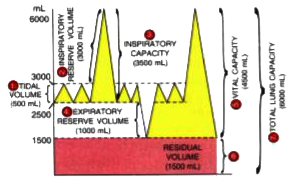Arrange the following terms based on their volumes in an asceding order.
(a) Tidal volume (TV)
(b) Residual volumn (RV)
(c ) Inspiratory Reserve volumn (IRV)
(d) Expiratory Capacity (EC)
To arrange the given terms based on their volumes in ascending order, we first need to understand what each term represents and their approximate volumes:
1. Tidal Volume (TV): This is the amount of air that moves in or out of the lungs with each respiratory cycle. The approximate volume is around 500 ml.
2. Residual Volume (RV): This is the volume of air remaining in the lungs after maximum forceful expiration. The approximate volume is about 1200 ml.
3. Inspiratory Reserve Volume (IRV): This is the amount of extra air inhaled above the tidal volume during a forceful breath in. The approximate volume is around 2500 ml to 3000 ml.
4. Expiratory Capacity (EC): This is the total amount of air that can be exhaled after a maximal inhalation. The approximate volume is around 1000 ml.
Now, let's arrange these volumes in ascending order:
- Tidal Volume (TV): ~500 ml
- Expiratory Capacity (EC): ~1000 ml
- Residual Volume (RV): ~1200 ml
- Inspiratory Reserve Volume (IRV): ~2500 ml to 3000 ml
Thus, the ascending order based on their volumes is:
1. Tidal Volume (TV)
2. Expiratory Capacity (EC)
3. Residual Volume (RV)
4. Inspiratory Reserve Volume (IRV)
Final Answer:
Tidal Volume (TV) < Expiratory Capacity (EC) < Residual Volume (RV) < Inspiratory Reserve Volume (IRV)
2. Residual Volume (RV): This is the volume of air remaining in the lungs after maximum forceful expiration. The approximate volume is about 1200 ml.
3. Inspiratory Reserve Volume (IRV): This is the amount of extra air inhaled above the tidal volume during a forceful breath in. The approximate volume is around 2500 ml to 3000 ml.
4. Expiratory Capacity (EC): This is the total amount of air that can be exhaled after a maximal inhalation. The approximate volume is around 1000 ml.
- Expiratory Capacity (EC): ~1000 ml
- Residual Volume (RV): ~1200 ml
- Inspiratory Reserve Volume (IRV): ~2500 ml to 3000 ml
2. Expiratory Capacity (EC)
3. Residual Volume (RV)
4. Inspiratory Reserve Volume (IRV)
Tidal Volume (TV) < Expiratory Capacity (EC) < Residual Volume (RV) < Inspiratory Reserve Volume (IRV)
Topper's Solved these Questions
- BOOK - NCERT EXEMPLAR ENGLISHCHAPTER - BREATHING AND EXCHANGE OF GASESEXERCISE - SATQ7videos
BREATHING AND EXCHANGE OF GASES
- BOOK - NCERT EXEMPLAR ENGLISHCHAPTER - BREATHING AND EXCHANGE OF GASESEXERCISE - SATQ7videos
BREATHING AND EXCHANGE OF GASES
- BOOK - NCERT EXEMPLAR ENGLISHCHAPTER - Body Fluids and Circulation EXERCISE - LONG ANSWER TYPE Q5videos
Body Fluids and Circulation
- BOOK - NCERT EXEMPLAR ENGLISHCHAPTER - CELL : THE UNIT OF LIFE EXERCISE - Long Answer Type Questions1videos
CELL : THE UNIT OF LIFE
Similar Questions
Arrange the following in the order of increasing volume
1) Tidal volume
2) Residual volume
3) Expiratory reserve volume
4) Vital capacityView SolutionFrom the following relationship between respiration volumes and capacities, mark the correct option.
(i) Inspiratory Capacity (IC) = Tidal Volume + Residual Volume
(ii) Vital Capacity (VC) = Tidal Volume (TV) + Inspiratory Reserve Volume (IRV) + Expiratory Reserve Volume (ERV)
(iii) Residual Volume (RV) = Vital Capacity (VC) - Inspiratory Reserve Volume (IRV)
(iv) Tidal Volume (TV) = Inspiratory Capacity (IC) - Inspiratory Reserve Volume (IRV)View Solution
Knowledge Check
- Question 1 - Select One
From the following relationship between respiration volumes and capacities, mark the correct option.
(i) Inspiratory Capacity (IC) = Tidal Volume + Residual Volume
(ii) Vital Capacity (VC) = Tidal Volume (TV) + Inspiratory Reserve Volume (IRV) + Expiratory Reserve Volume (ERV)
(iii) Residual Volume (RV) = Vital Capacity (VC) - Inspiratory Reserve Volume (IRV)
(iv) Tidal Volume (TV) = Inspiratory Capacity (IC) - Inspiratory Reserve Volume (IRV)A(i) Incorrect, (ii) Incorrect, (iii) Incorrect, (iv) CorrectB(i) Incorrect, (ii) Correct, (iii) Incorrect, (iv) CorrectC(i) Correct, (ii) Correct, (iii) Incorrect, (iv) CorrectD(i) Correct, (ii) Incorrect, (iii) Correct, (iv) Incorrect
From the following relationship between respiration volumes and capacities, mark the correct option.
(i) Inspiratory Capacity (IC) = Tidal Volume + Residual Volume
(ii) Vital Capacity (VC) = Tidal Volume (TV) + Inspiratory Reserve Volume (IRV) + Expiratory Reserve Volume (ERV)
(iii) Residual Volume (RV) = Vital Capacity (VC) - Inspiratory Reserve Volume (IRV)
(iv) Tidal Volume (TV) = Inspiratory Capacity (IC) - Inspiratory Reserve Volume (IRV)View SolutionFrom the following relationship between respiration volumes and capacities, mark the correct option.
(i) Inspiratory Capacity (IC) = Tidal Volume + Residual Volume
(ii) Vital Capacity (VC) = Tidal Volume (TV) + Inspiratory Reserve Volume (IRV) + Expiratory Reserve Volume (ERV)
(iii) Residual Volume (RV) = Vital Capacity (VC) - Inspiratory Reserve Volume (IRV)
(iv) Tidal Volume (TV) = Inspiratory Capacity (IC) - Inspiratory Reserve Volume (IRV)View SolutionArrange the following in ascending manner basing on their life span
(a) Carrot (b) Wolffia (c ) Rosa plant (d) Pinus plantView SolutionArrange the following substances in order of their increasing density :
(a) iron (b) cork (c) brass (d) water (e) mercury.View SolutionIf Expiratory Reserve Volume = a , Residual Volume = B , Tidal Volume = C and Inspiratory Reserve Volume = D, then Funtional Residual Capacity (FRC) is equal to
View SolutionArrange the following in an ascending order of volume
1 expiratory reserve volume
2 inspiratory capacity
3 tidal volume
4 residual volumeView SolutionThe volume of air in the lungs and the rate at which it is exchanged during inspiration and expiration was measured.
The following diagram shows a group of the lung volumes and capacities :

Study the diagram carefully and explain briefly the following:
(a) Tidal volume
(b) Inspiratory reserve volume
(c) Expiratory reserve volume
(d) Vital capacity
(e) Residual volumeView Solution

